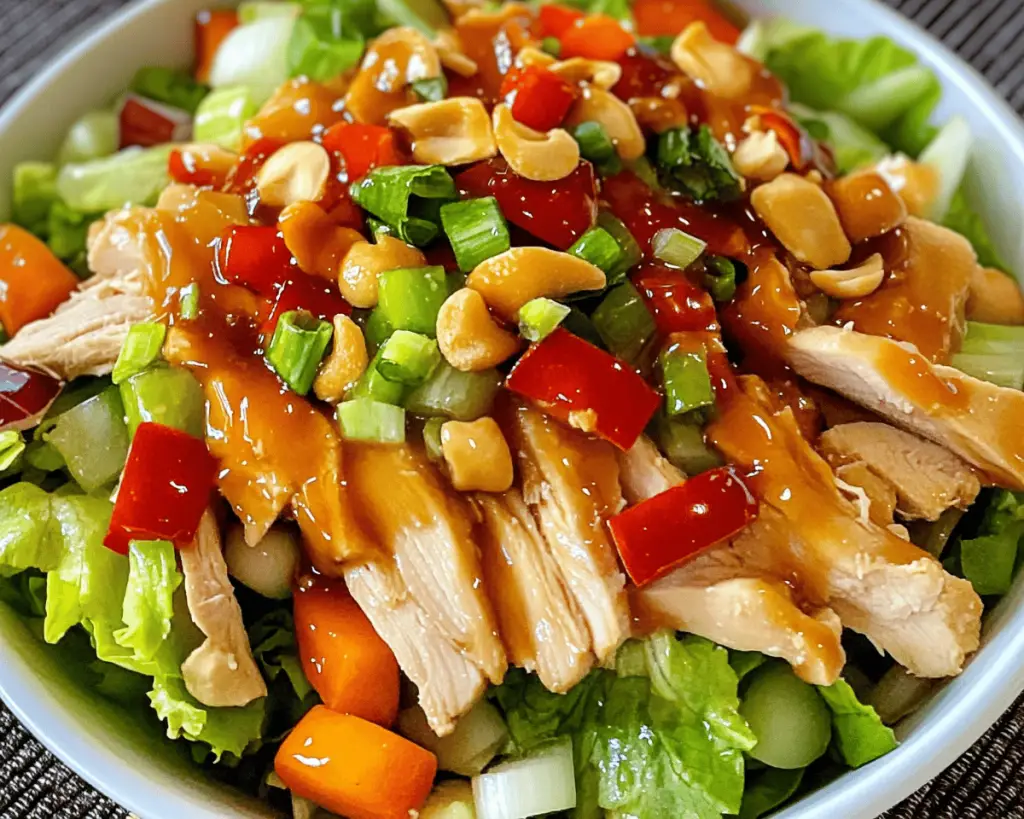When I think of Chinese Chicken Salad, my mind drifts back to sun-kissed picnics under the shade of towering oak trees in the park near my childhood home. It was there that my mom first introduced me to this vibrant dish, a medley of flavors and textures that danced across the palate. I can still remember the sound of laughter mingling with the crisp crunch of fresh vegetables and the subtle, tantalizing zing of sesame dressing. Each bite painted a picture—a burst of color and a hint of nostalgia that seemed to distill summer into a single bowl.
The origins of Chinese Chicken Salad are as layered as the salad itself. It’s a culinary tapestry woven with threads of American flair and traditional Asian tastes. I’ve come to appreciate how each ingredient interacts—the sweet, juicy chicken, the snap of lettuce, the crunch of toasted almonds, and the zesty pop of mandarin oranges. It stands as a testament to cultural exchange in our palate, and every time I prepare it, I’m reminded of those sunny afternoons filled with family and friendship.
Making Chinese Chicken Salad is rooted in mindfulness and care. The choice of fresh ingredients is imperative—each one a character in the story of this dish. It teaches joy in preparation, and it encourages creativity and adjustments based on what’s fresh or available. Whether I’m entertaining guests or just treating myself, I am reminded that good food doesn’t just fill the stomach—it nourishes the soul.
Over the years, I’ve found this salad to be incredibly versatile, adapting it to the seasons and the whims of those I serve. There’s something both comforting and exciting about creating a dish that holds such potential for personalization. This recipe has become a staple in my kitchen, not merely for its taste but for the memories it evokes and the delight it brings. So, let’s take a comforting dive into the heart of this beloved recipe.
Inside the Ingredients of Chinese Chicken Salad
Creating an enjoyable Chinese Chicken Salad begins with understanding its core ingredients. Here’s what you’ll need and the role each plays in this refreshing dish.
Chicken Breast: The foundation of this salad, chicken breast serves as the centerpiece. Its mild flavor readily absorbs the zest of the other ingredients, and when grilled or poached, it becomes tender and juicy. I prefer using organic chicken when possible—not just for the taste, but also for the ethical choice it represents. If you’re in a pinch, rotisserie chicken can stand in beautifully and save you time.
Mixed Greens: A combination of romaine and green leaf lettuce brings a lovely crunch and vibrant color. But don’t feel confined to just these! I enjoy experimenting with baby spinach, arugula, or even shredded Napa cabbage for a unique twist. The goal is to incorporate greens that will contrast nicely with the richness of the chicken and the complex flavors of the dressing.
Mandarin Oranges: These gems of citrus offer bursts of sweetness that balance the savory elements. I often use fresh mandarins when they’re in season, but canned ones in juice can be a suitable alternative. Just remember to drain them well to prevent excess liquid from watering down the salad.
Carrots: Shredded carrots contribute not only a beautiful splash of orange but also a refreshing crunch. They are a powerhouse of nutrition, rich in beta-carotene, and add a natural sweetness. I’ve tried using purple or yellow carrots for added color; it turns out beautifully!
Red Bell Pepper: Not just for visual appeal! The crisp, sweet bite of red bell pepper enhances the texture and brings an additional depth of flavor to the mix. Feel free to substitute with green bell pepper or even thinly sliced snap peas for a different flair.
Cucumber: Sliced or julienned, cucumbers add hydration and coolness—perfect for a salad meant to feel refreshing. I’ve grown fond of using English cucumbers that come with fewer seeds. However, if you prefer a more robust flavor, consider using Persian cucumbers.
Almonds: Toasted sliced almonds provide a nice crunch as well as a nutty flavor that complements the dressing. If you’re feeling adventurous, you could also use sesame seeds for an added layer of flavor, or even cashews for a slightly sweeter note.
Green Onions: Often forgotten, green onions add a mild sharpness that elevates the dish. I love the fresh, crisp bite, finely sliced and sprinkled over the top just before serving. They not only enhance flavor but also provide that pop of green that makes the dish visually appealing.
Sesame Oil: This aromatic oil is integral to the dressing, lending a unique nuttiness that is quintessential in Asian cuisine. A little goes a long way, so remember to use it sparingly and balance it with the other dressing components.
Rice Vinegar: Bright and tart, rice vinegar is a key ingredient in balancing the dressing. It has a milder flavor than regular vinegar, which complements the other ingredients without overpowering them. Should you need a substitute, apple cider vinegar in small amounts can be a fine alternative.
Soy Sauce: A simple splash of soy sauce enhances the umami flavor profile. It’s a staple in many Asian dishes and adds depth without needing additional salt. For a gluten-free option, tamari works beautifully without sacrificing flavor.
Honey: Just enough to round out the dressing with a touch of sweetness. Local honey can bring an additional depth of flavor, and if you’re avoiding sweeteners, consider using agave syrup or maple syrup as alternatives.
How Chinese Chicken Salad Fits Into a Balanced Life
In today’s fast-paced world, finding balance in our diets can seem daunting. Chinese Chicken Salad shines as a bright spot in my cooking repertoire for its nutrition and versatility. The vibrant mix of vegetables ensures a wealth of vitamins and minerals is present, providing nourishment without feeling heavy.
The combination of lean protein from the chicken and healthy fats from the almonds makes it a well-rounded meal. Typically, I serve this salad as a light dinner, perhaps paired with a bowl of miso soup or some whole grain rice. The protein keeps me satisfied without that sluggish feeling that heavier meals can bring.
In terms of dietary considerations, I’m often mindful of those with specific restrictions. For gluten-free options, simply ensure that both the soy sauce and any pre-packaged dressings are labeled gluten-free. Adjusting the salad for vegetarians is easy too; tofu or chickpeas can provide necessary protein and texture without compromising the spirit of the dish.
It’s also worth acknowledging the aspect of indulgence—after all, cooking and eating should bring joy! I’ve enjoyed occasions where I unapologetically loaded my salad with crispy wontons for an added crunch or drizzled on additional dressing to please my taste buds. Striking harmony between nutritious choices and flavor is how I maintain balance in my culinary adventures.
What You’ll Need
– 2 cups cooked and shredded chicken breast
– 4 cups mixed greens (romaine, green leaf, etc.)
– 1 cup canned mandarin oranges or fresh, segmented
– 1 cup shredded carrots
– 1 cup diced red bell pepper
– 1 cup sliced cucumber
– ½ cup toasted almonds
– 2-3 chopped green onions
– 2 tablespoons sesame oil
– 2 tablespoons rice vinegar
– 1 tablespoon soy sauce
– 1 tablespoon honey
This recipe serves approximately 4-6, making it perfect for a family meal or a gathering with friends.
Preparing Chinese Chicken Salad Step by Step
1. **Prepare the Chicken**: If you’re starting with raw chicken, I typically season it lightly with salt and pepper, then grill or poach it until cooked through. Let it cool before shredding. If using rotisserie chicken, simply shred it with your fingers or a fork. There’s something wonderfully satisfying about pulling apart tender chicken, and it always reminds me of my mom’s kitchen.
2. **Prep the Vegetables**: While the chicken cools, wash and dry your greens thoroughly—no one wants a soggy salad. Using a sharp knife or mandoline, chop the lettuce into bite-sized pieces. Then proceed to julienne the carrots, slice the cucumbers, and dice the bell pepper. It’s a meditative process for me, one that allows me to appreciate the colors and shapes of the fresh produce.
3. **Make the Dressing**: In a small bowl, whisk together the sesame oil, rice vinegar, soy sauce, and honey. I like to taste as I go, allowing the flavors to meld together perfectly. This little ritual not only elevates the dressing but also gives me a connection to the dish itself.
4. **Assemble the Salad**: In a large bowl, combine the mixed greens, carrots, cucumber, bell pepper, and mandarin oranges. Gently toss in the shredded chicken. This is where I get really enthusiastic—watching the colors come together reminds me of painting a picture.
5. **Add the Toppings**: Sprinkle in the toasted almonds and chopped green onions. A good rule of thumb is to reserve some of the toppings for garnishing later; it adds visual appeal when serving.
6. **Dress the Salad**: Just before serving, drizzle the prepared dressing over the salad. Toss gently but thoroughly, ensuring every piece is coated. This final step is like giving the salad a hug, embracing each fresh ingredient with the loving flavors of your creation.
7. **Serve with Joy**: Transfer everything into a beautiful serving bowl, or for a more casual approach, plate individual servings. Take a moment to admire your work before digging in!
Lessons from My Kitchen
Throughout my culinary journey, I’ve learned valuable lessons that have influenced how I present my dishes. Preparing Chinese Chicken Salad has been no exception. Early on, I faced mishaps, like forgetting to add the dressing before serving or serving the greens a moment too late, wilting them ever so slightly. Those small stumbles became great teachers, and now I ensure to have everything prepped and ready—mise en place is my faithful friend.
As I’ve continued to make this salad, I’ve discovered delightful alternatives that spark creativity. Mixing up the protein—from grilled shrimp to enlisting crispy tofu—has broadened my horizon and adaptability in the kitchen. Seasonal variations keep my family excited; during the summer months, ripe peaches or berries can replace the mandarin oranges, lending a delightful sweetness that dances on the tongue.
During wintertime, a handful of roasted butternut squash cubed into the mix provides warmth, keeping the essence of the dish alive while embracing the seasonal produce. Each change tells a new story, one composed of ingredients that resonate with the time, place, and gathering at hand.
Lastly, this recipe has taught me that cooking should always be a reflection of who we are and where we come from. As I prepare this salad, I think of the flavors I enjoy and the memories tied to them. It’s a living canvas, evolving through time, experiences, and even the voices of those I share it with.
I cherish the moments when family and friends gather around the table—savoring, sharing stories, laughter, and joy. Food binds us, and in that binding comes the comfort of connection.
As you embark on making this Chinese Chicken Salad, I hope you find warmth, happiness, and perhaps a few new stories of your own to tell. Remember, cooking is as much about the journey as it is about the destination. So go ahead, mix and match, embrace creativity, and enjoy every bite!



